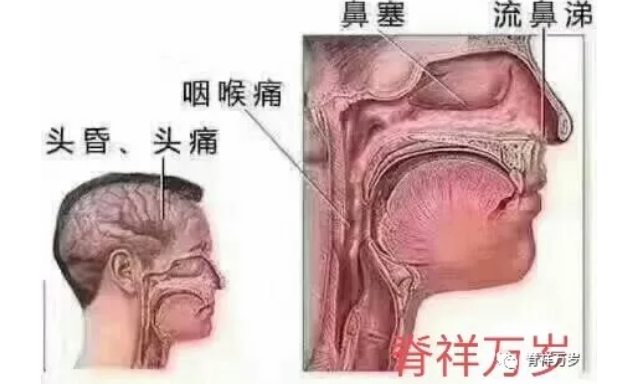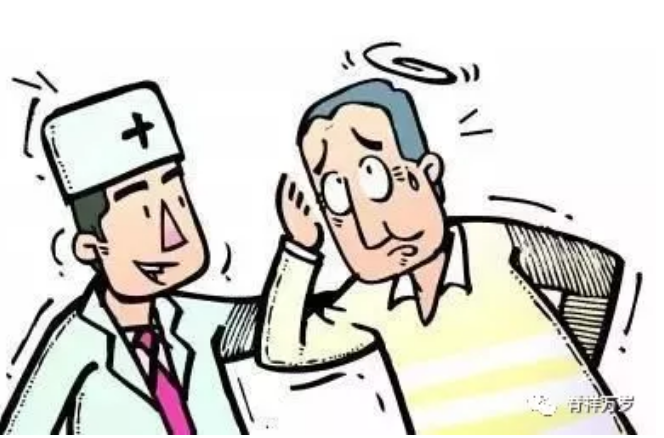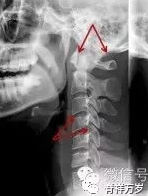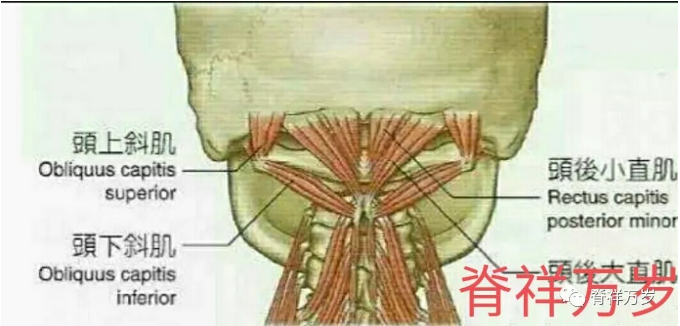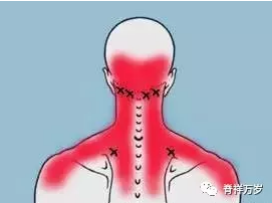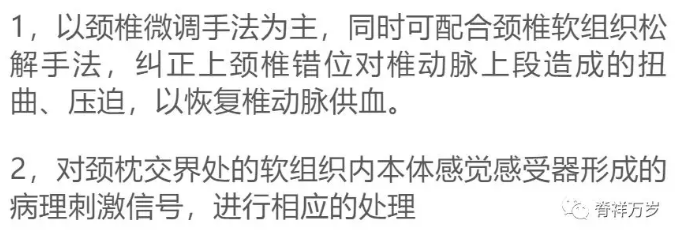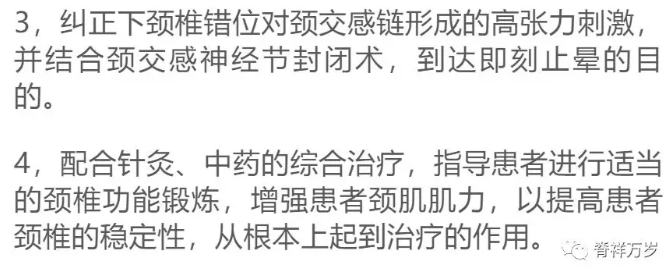
Service hotline:
13533607738
18602592233
Welcome to 广东脊祥万岁健康管理有限公司!
最新资讯
In clinic, vertigo does belong to "difficult and complicated disease", but it is not "terminal disease". If you ask, why can't many vertigo patients be cured? That's because from the point of view of Western medicine, cervical spondylosis is seldom thought to cause vertigo. Today, we will talk about this issue from the perspective of manipulative therapy. 1、Summary of "Cervical Vertigo" 2、Three main types of vertigo 3、Four Thoughts on the Treatment of Vertigo 4、Daily prevention of vertigo Summary of "Cervical Vertigo" Ⅰ Cervical vertigo The so-called "cervical vertigo" must be closely related to the cervical spine. Without cervical discomfort, there would be no cervical vertigo. This also reminds us that if patients with vertigo and dizziness are accompanied by neck and shoulder discomfort, we should consider the possibility of neck vertigo. Even without the above symptoms, the patient must have a long-term career history of bowing his head to the desk, a history of chronic neck pain or a history of cervical trauma. Ⅱ Typing Traditional medical education divides vertigo into true vertigo and false vertigo according to its nature. According to the location of the lesion, it can be divided into systemic vertigo and non-systemic vertigo. Systemic vertigo can be divided into central vertigo and peripheral vertigo, mostly vestibular system lesions. Non-systemic vertigo mainly includes eye diseases, hypertension, anemia, heart disease, moderate and neurosis. At present, the diagnosis of vertigo in western medicine is nothing more than "Meniel's disease", "vestibular disease", "cerebrovascular disease". Vertigo is seldom diagnosed as "cervical spondylosis" or "cervical vertigo". However, from the point of view of physical rehabilitation, vertigo is not only related to eyes, ears and brain, but also to a large extent with the dislocation of the first and second cervical spine joints (atlantoaxial joints) and tight occipital posterior muscles. Zhang, and the disturbance of proprioceptors in the posterior cervical muscles. Ⅲ Symptom Vertigo is the main symptom. Morning onset is common. Vertigo can be chronic and persistent, and can also be manifested as paroxysmal severe vertigo. Most of them occur when they turn their heads, bow their heads or look up. In serious cases, they may even suddenly collapse, but their consciousness is always clear. Patients often feel depressed, fatigue, sleepiness, nausea and vomiting, tinnitus, deafness, visual impairment, often accompanied by neck pain, stiffness, headache and other symptoms. Ⅳinspect The muscles from the back of the neck to the scapula were obviously tense, the ribs and tendons were obvious, the activity of the cervical spine was reduced, and the various joints of the cervical spine were dislocated. X-ray examination of the cervical spine showed that the physiological curvature of the cervical spine changed, the intervertebral space narrowed, osteophytes proliferated obviously, the intervertebral foramen became smaller, and the atlantoaxial joint was obviously asymmetrical. Further examination will find vertebral artery blood flow disorders, disc herniation and so on. Ⅴ Reason The onset and relief of vertigo are often related to the location of the neck. When turning head suddenly, stretching back or lowering head, vertigo is easy to aggravate, and it can be alleviated after restoring neutral position. In clinic, dizziness or aggravation of dizziness may occur in different locations of head and neck to make more detailed etiological diagnosis. Three main types of vertigo ⅠDirect or indirect compression of vertebral artery Vertigo Most of them are subluxation of atlantoaxial joint or transverse hyperplasia of uncinate joint. When turning head, vertigo occurs due to insufficient blood supply caused by stimulation or compression of dislocated atlantoaxial joint or transverse hyperplasia of uncinate joint. X-ray films of cervical spine showed asymmetry of atlanto-dental space more than 3 mm, or straightening of cervical curvature, transverse hyperplasia of uncinate joint (mostly in C5-6 space). Vertigo Because the vertebral artery travels below the triangular space surrounded by the posterior rectus magnus, superior oblique and inferior oblique muscles, when the muscles are tense, lowering the head can further draw the muscles closer to stimulate or compress the vertebral artery directly, leading to vertigo attacks. During physical examination, there was obvious tenderness near the suboccipital line, the first cervical transverse process and the second cervical spinous process. Dizziness on the head The posterior atlanto-occipital membrane was found in the deep layers of the superior trapezius, the semispinous muscle and the posterior rectus minor. When the tension of the muscle group was indirectly stimulated or compressed through the posterior atlanto-occipital membrane, vertigo attack was caused. During physical examination, there were obvious tenderness on the bone surface, medial edge of scapula and scapular spine between the upper and lower occipital line. The atlanto-occipital space was less than 6 mm on the lateral film of cervical spine. ⅡSympathetic disorder The clinical characteristics of vertigo caused by sympathetic nerve disorder are chronic vertigo. The occurrence and aggravation of vertigo have nothing to do with head and neck posture. Head, occipital and top skin can touch different degrees of edema and thickening, which is the manifestation of vascular motor dysfunction. Craniocerebral color Doppler (TCD) examination indicated spasm of internal carotid artery system and/or vertebral artery system. Ⅲ Posterior cervical muscle group proprioceptive disorder Vertigo caused by proprioceptive sensory disturbance of posterior cervical muscles is more common in chronic and moderate degree. Vertigo is aggravated in lower head position or extreme backward extension position, and can be alleviated in neutral position. Posterior cervical muscle group tends to be tense, moderate massage of the posterior cervical muscle group can significantly alleviate vertigo; sometimes the sign of upper cervical spine dislocation can be seen. Often accompanied by palpitations, insomnia, depression, anxiety, headache and other neurological disorders, patients are often too sensitive to changes in their own physical condition. In clinic, vertigo caused by sympathetic nerve disorder and proprioceptive sensory disorder of posterior cervical muscles is seldom completely independent, and is often accompanied by vertigo caused by direct or indirect compression of vertebral artery by joints or muscles. Four Thoughts on the Treatment of Vertigo In clinic, the rehabilitation treatment of vertigo is mainly aimed at relieving vertebral artery pressure, sympathetic nerve stimulation and proprioceptive disturbance. The following four ideas can be considered in the treatment of vertigo by hand.: Daily prevention of vertigo Ⅰ Pay attention to sleeping posture The best posture is the right side recumbent position, the pillow's softness and hardness, high and low position, should fully consider the comfort of the neck. When lying on the back, the pillow should be placed between the head and shoulder, so that the physiological lordosis of the cervical spine can be filled with the depression between the bed surface. Ⅱ Pay attention to sitting posture The buttocks should fully touch the chair surface, the waist should be straight, the shoulders should be turned outward, so that the head, neck, shoulder and chest can maintain a slightly tightened normal physiological curve. Close the distance between the body and the worktable as far as possible, and adjust the height of the desk and chair to the most appropriate position with their own height, in order to reduce fatigue caused by long sitting. If the work needs a long time, it is better to move the lower neck regularly, every hour or so, stand up and walk below, do stretching exercises, reduce the tension of the head, neck, shoulder and back muscles. Ⅲ Keep warm When the weather is cold, we should pay attention to the warmth of the neck, especially the middle-aged and old friends, because cold and cold are also one of the factors that lead to the contraction, stiffness and vertigo of the neck vessels and muscles. Similarly, in the air-conditioned space in summer, we should also be careful about the damage of air-conditioned air to the cervical spine. We can tie a silk scarf around the neck. Ⅳ Avoid trauma Strong injuries can directly damage the cervical spine, and the most easily overlooked is the neck problem caused by car rear-end collision. Quite a number of patients do not care at first because there is no obvious trauma, but they do not know that the cervical spine has been damaged, which buries hidden dangers for cervical vertigo or even more serious cervical spondylosis. I would like to remind you that if you fall back carelessly, or suddenly sprain your neck, you should go to the hospital in time for examination. Ⅴ Take a rest Ensuring adequate sleep and high sleep quality is a good way to deal with insomnia, neurasthenia, other nervous system diseases and cardiovascular problems. Poor rest can also induce cervical vertigo.